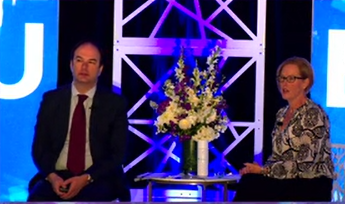Current overview of patient services policy in the US

Discussions at Access USA 2025 focused on accumulator and maximizer programs, Medicare Part D smoothing, and state-based prescription drug affordability boards and maintaining flexibility and vigilance on PAPs of the future.
The “Policy Address: 2025 State of the Patient Services Industry” session started off with one of the ever-evolving and long-standing issues in patient services policy—accumulator and maximizer programs. These initiatives, implemented by health plans and pharmacy benefit managers (PBMs), aim to limit the impact of manufacturer copay assistance on patient out-of-pocket costs.
 Michael Kolber and Jennie Sakimura on stage at Access USA.
Michael Kolber and Jennie Sakimura on stage at Access USA.
Jennie Sakimura, Senior Director of Patient Services and Specialty Pharmacy Programs at Sanofi, noted a shift. “I’m seeing accumulators becoming less prevalent, but I’m seeing maximizers certainly pick up momentum.” This trend reflects the industry’s adaptation to patient and regulatory pushback against accumulator programs, which often resulted in unexpected out-of-pocket costs for patients at the pharmacy counter.
Sakimura also noted that some pharma companies are aligning their copay support programs with government rules. This schema allows out-of-pocket limits of $9,200 per year for an individual and $18,400 for a family.
Michael Kolber, partner at Manatt, Phelps and Phillips, added, “It seems like what the bigger dynamic here is that there’s some recognition that accumulators are pretty patient unfriendly ... And it makes sense that there’s this shift as you’re describing to maximizers, where the patient harm is frankly harder to articulate and is probably seen more as a win-win from the plans’ perspective.”
However, Kolber noted, in order to “shift” patients in their plans, alternative funding plans (AFPs) are receiving more take up. He explained that plans will say the drug isn’t covered at all, but you can go to the manufacturer via the AFP to see if you are eligible for free coverage, and if you aren’t, the plan will cover through an exception process. Kolber said this too is extremely patient unfriendly, and he hinted that PBMs themselves might not like these programs because they lose control of the patient utilization, rebates, and formulary management. “I’m hopeful that it will be somewhat self-limiting,” Kolber said.
Medicare Part D smoothing plan
The implementation of the Inflation Reduction Act (IRA) brings significant changes to Medicare Part D, including a $2,000 out-of-pocket cap and the introduction of the Medicare Prescription Drug Payment Plan (M3P) smoothing program.
However, the rollout of these programs has faced criticism. Kolber pointed out, “There was a lot of criticism about how it was set up, both in statute and operationally by CMS, including that patients need to opt into it at all. It's strange why they should have to.”
Sakimura added, “I think the consensus is it's been very low adoption across the board.” This low uptake highlights the challenges in implementing even well-intentioned policies effectively.
State-level prescription drug affordability boards
As federal efforts face hurdles, states are taking matters into their own hands. Several states have established Prescription Drug Affordability Boards (PDABs) with the authority to set upper payment limits on certain drugs.
“There are four states that have created prescription drug affordability boards that have authority to set these upper payment limits. There are more states that have PDABs that don't have UPL (upper payment limit) authority today,” Kolber explained.
However, these efforts face legal challenges, with four states—Colorado, Maryland, Washington, and Minnesota—on various grounds of legality. Amgen’s lawsuit against Colorado’s PDAB was decided on March 28 against the pharma company.
As the policy landscape evolves, patient support programs must adapt. Sakimura suggests a potential shift in strategy. “I’m wondering if we had a crystal ball here, if maybe that wasn’t the right decision, as formularies continue to become more restrictive that you might have legit carve-outs where there’s a lot of patients affected that may need assistance.”
Kolber added, “I wouldn’t expect a legislative fix here, certainly not in the near future. This reality means that all stakeholders — from policymakers to manufacturers to patient advocacy groups — must remain vigilant and adaptable in their efforts to balance patient access with cost containment in the years to come.”
Quotes have been lightly edited for clarity.
Lead photo: Depositphotos@lighthouse